Exploring Card Reading for Fortune Telling
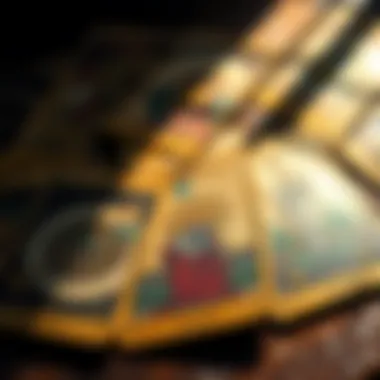
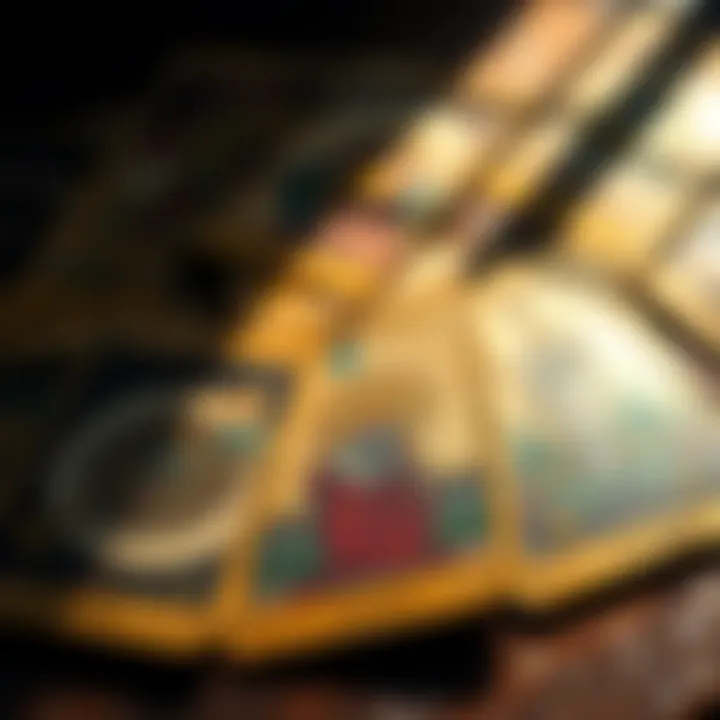
Intro
Reading cards for fortune telling is more than simply a practice; it’s a window into the universe’s mysteries. This art form has deep roots, intertwining history, psychology, and intuition. At its core, using cards like tarot and oracle to glean insights about the past, present, and future taps into an age-old quest for knowledge that transcends cultural barriers.
In recent years, the popularity of card readings has surged. People are searching for understanding and connection in a world that often feels chaotic and overwhelming. These cards can serve as a bridge to delve into one's psyche, often sparking revelations that can lead to personal growth.
However, the journey does not stop there. The methodologies of reading cards can vary widely, influenced by traditions, personal preferences, and individual intuition. By exploring different card systems, seekers can find methods that resonate with them, enhancing both their personal practices and professional endeavors.
As we traverse this intricate landscape in the sections ahead, readers will not only gain insights into the historical significance and methodologies of card reading but will also uncover how intuition plays a pivotal role in this esoteric art. Dive in, and let’s peel back the layers of mystique surrounding the practice of card reading.
Historical Overview of Card Reading
The practice of card reading for fortune telling stretches back centuries, weaving through various cultures and evolving alongside the human experience. Understanding its vast and intricate history is crucial for anyone delving into this mystical art. This historical exploration not only illuminates the roots of tarot and oracle cards but also reveals how cultural perceptions and practices have shaped our modern approaches to divination. Examining these historical trajectories helps practitioners appreciate the complexity behind card reading as a form of insight and guidance.
Origins of Tarot and Oracle Cards
The origins of tarot and oracle cards remain somewhat shrouded in mystery, often leading to debates among enthusiasts and scholars. Tarot cards are believed to have first emerged in the 15th century in Europe, specifically in Italy, as a playing card game known as tarocchi. Initially, these cards did not hold any mystical significance but later transformed into instruments of divination. As tarot spread throughout Europe, it absorbed various cultural influences, which enriched its symbolism and interpretations.
Meanwhile, oracle cards have a different lineage, often considered more spontaneous and adaptable in nature. These decks, as early as the 19th century, were developed to provide guidance, tapping into the intuitive abilities of the reader. An oracle card reading is often broader in scope, focusing on themes rather than specific questions, which can appeal to individuals seeking a more open approach.
Evolution of Card Reading Practices
Over time, the practices associated with card reading have evolved significantly. During the Renaissance, interest in astrology, alchemy, and the occult led to a renewed fascination with tarot. This period saw the emergence of notable tarot decks, like the Visconti-Sforza deck, which remain influential in today's interpretations. As the art of reading cards developed, it also became more accessible to the wider public, shifting from elite circles to more common folk.
Today, card reading encompasses a variety of techniques and interpretations. From traditional methods that honor historical structure to contemporary approaches embracing creativity, the evolution reflects a dynamic interplay between personal belief and cultural symbolism. Inasmuch, practitioners now often blend elements from various traditions, tailoring their readings to align with individual energies or inquiries.
Cultural Influences on Fortune Telling
Cultural influences play a vital role in shaping the practice of card reading across the globe. In many regions, cards serve not only as tools for divination but are also deeply embedded in cultural narratives and mythos. For instance, in some Indigenous communities, card reading can grow out of storytelling traditions, where the cards help articulate teachings, lessons, or guidance relevant to that culture’s heritage.
In contrast, influences from Eastern philosophies have also left their mark. The integration of concepts from Buddhism and Taoism into western practices has introduced new dimensions of spirituality to card reading, often reflecting a blend of meditation and intuition.
As cultural landscapes continue to shift, card reading persists as a fluid practice that captures the essence of diverse beliefs and values. This ongoing dialogue between the old and the new not only helps preserve the historical significance but also emboldens future interpretations and practices.
"Understanding history provides context to our present practices, allowing for a richer and deeper engagement with the art of card reading."
End of Historical Overview
The historical overview of card reading reveals much about human nature and our desire for connection to the unseen. By appreciating these origins, evolutions, and cultural influences, practitioners can enrich their card reading experiences. They can understand that every shuffle, every spread, is not just a personal journey but part of a larger, shared tapestry of human wisdom.
Psychological Foundations of Card Reading
The realm of card reading extends beyond mere symbols on paper; it's profoundly tied to the human psyche. Understanding the psychological foundations empowers both practitioners and seekers, giving depth to the interpretative process. The significance lies in how these elements—intuition, cognitive biases, and emotional responses—intertwine to shape experiences in fortune telling. This section will explore these foundations, explaining their relevance and guiding how to approach readings with a nuanced understanding of the mind.
Intuition and Interpretation
Intuition functions as the heart of card reading. It's that inner voice echoing thoughts and feelings, guiding the reader toward insights that often can't be articulated in words. When a reading begins, tapping into this instinctive knowledge can make all the difference. Unlike a formal analysis grounded in logic, intuition makes connections that are felt rather than calculated.
Readers should allow themselves to embrace this intuitive understanding. It can often mean paying attention to gut feelings when certain cards appear or resonate more strongly than others. For instance, when a tarot card like The Moon surfaces, it can signify hidden fears or illusions—not just because the book says so, but because the reader feels it. This personal connection enhances the experience and makes the reading more relevant.
Intuition also deepens during interactions with clients. As emotions flow, a reader's ability to sense the underlying feelings of the person seeking guidance becomes enhanced. Contextual clues transform intuition into applied understanding. Each reading signifies a partnership, where both the reader and querent contribute to the unfolding of insight.
The Role of Cognitive Biases
As much as we want to rely on intuition, cognitive biases can slip into the interpretation process. These mental shortcuts can shape perceptions and lead to misinterpretations. A popular bias in card reading is confirmation bias, where the reader sees what they expect to see, reinforcing preconceived notions instead of objective insights.
Awareness of these biases fosters a more critical approach. For example, if a reader is predisposed to view a specific card—like The Tower—as purely negative, they might overlook positive elements involved, such as transformation or growth through chaos. This is where the art of card reading becomes a dance of balance: weighing intuition against cognitive pitfalls. Regular reflection and self-awareness can mitigate biases, encouraging a more open-minded interpretation that respects the complexity of each card's meaning.
Emotional Responses to Readings
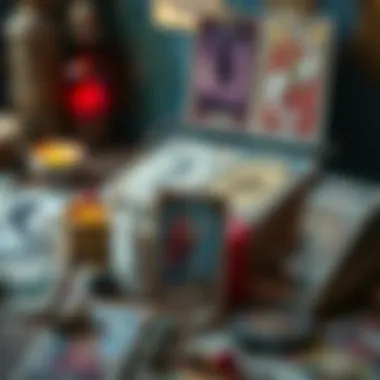
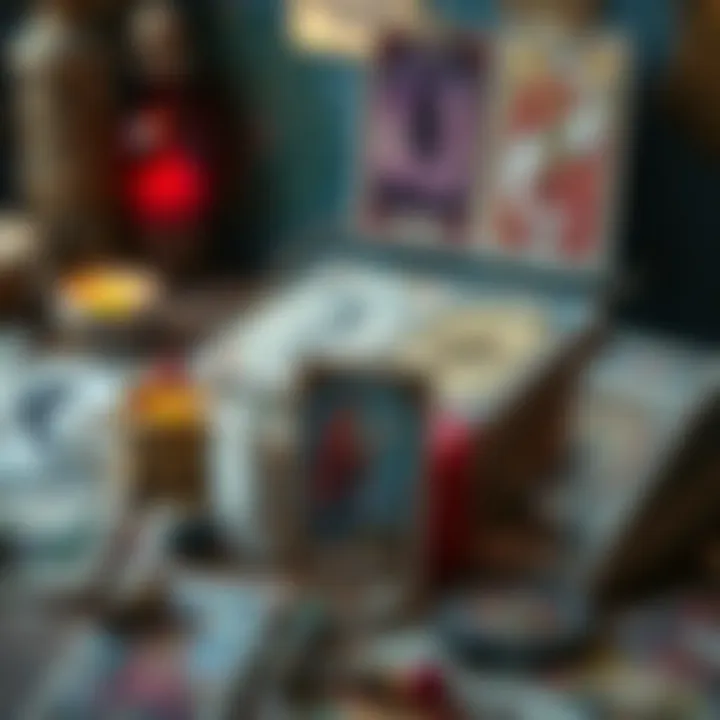
Emotions play a pivotal role in the dynamics of card reading. Both the reader and the querent experience emotional reactions that can color interpretations. It is vital to recognize this dimension because readings often unearth feelings that have long been hidden. This emotional landscape requires sensitivity and empathy.
When a querent sees a card depicting heartbreak, their immediate emotional response likely reflects their personal history with loss. A skilled reader must navigate these waters carefully, ensuring that the interpretation honors these feelings while still delivering the message from the cards. A response laden with empathy not only facilitates trust but also fosters deeper connections.
Readers should occasionally check in with themselves and the querent during the reading process to gauge emotional responses. A simple question like, "How does this resonate with you?" can illuminate interpretations and refine the focus on what truly matters. Evaluating both emotional and intuitive feedback aids in steering the reading back on course when sentiments run high.
Card reading thus serves not just as a tool for foresight or advice but as a conduit for psychological insights. As practitioners recognize the psychological foundations in play, they unlock the ability to offer more profound insights and foster meaningful interactions. Understanding our minds and emotions enhances this craft, enriching both the reading and the reader-querent relationship.
Understanding Different Card Systems
In the realm of fortune telling, understanding the various card systems is pivotal. Not only do these systems harbor unique methodologies, but they also serve distinct purposes in the nuanced art of reading cards. From tarot to oracle, each type presents its own framework and philosophy, enabling readers to connect with their intuition and provide insightful guidance.
Tarot Cards: Structure and Symbolism
Major Arcana
Delving into the Major Arcana is like opening a treasure chest of life's most profound journeys. This collection consists of 22 cards, each symbolizing significant life events or themes, like The Fool or The Lovers. A key characteristic of the Major Arcana is its narrative power—these cards stand out for their ability to depict major life lessons and spiritual awakenings. As a reader, choosing to start with Major Arcana gives you the tools needed to address critical life transformations.
The unique aspect of these cards is that they often resonate deeply with the querent, as they encapsulate pivotal existences or cycles. One major advantage they provide is their ability to spark reflective dialogue during a reading. However, relying solely on Major Arcana can sometimes narrow the reading's scope, making it less detailed about day-to-day matters or smaller challenges.
Minor Arcana
In contrast, the Minor Arcana focuses on the more mundane aspects of life—there are 56 cards categorized into suits such as Cups, Swords, Wands, and Pentacles. The strength of the Minor Arcana lies in its versatility, addressing questions about daily happenings, relationships, and small victories. A reader who utilizes Minor Arcana can capture the nuances of the querent's everyday experiences, illuminating the subtleties often overlooked in broader life themes.
A specific feature of these cards is their adaptability; for example, each suit corresponds to different emotional states and challenges—Cups representing emotions, Swords dealing with intellect and conflict, and so on. Despite their strengths, the depth may sometimes be compromised when focusing on intricate situations where the Major Arcana's insights are called for.
Oracle Cards: An Overview
Types of Oracle Decks
Oracle cards are a fascinating addition to the world of card reading, providing an extensive variety of decks designed to resonate at different vibrational levels. Unlike tarot, which adheres to a fixed structure, oracle decks come in numerous forms, each with their own themes, symbols, and interpretations. Whether they derive from nature, mythology, or specific spiritual traditions, the types of oracle decks add a colorful palette to the practice, making it more accessible and varied.
This diversity allows readers to select a deck that intuitively aligns with their personal style and intent, expanding the toolkit of insights available. One notable advantage is that many oracle decks are designed to be user-friendly, often featuring less complex imagery, making them appealing to both novice and seasoned readers alike. However, the sheer variety can lead to confusion, with so many options that one might feel overwhelmed.
Flexibility in Interpretation
A hallmark of oracle cards is their flexibility in interpretation. Unlike tarot, which follows a traditional narrative, oracle cards allow readers to draw from personal intuition and emotional resonance. This characteristic becomes particularly advantageous when readings need to be tailored to the querent's unique situation.
Readers appreciate this feature as it empowers them to explore messages that may resonate differently at various times or for different individuals. Although this high level of interpretive freedom can be liberating, it also introduces an element of subjectivity that might detract from those who prefer a more concrete structure in their readings.
Comparative Analysis: Tarot vs. Oracle
When comparing tarots with oracle cards, it becomes clear that both systems have unique strengths and weaknesses. Tarot tends to provide deep psychological insights and intricacies, while oracle offers a fresh, adaptable approach suitable for diverse situations. One isn't necessarily better than the other; rather, they complement each other beautifully in a well-rounded card reading practice.
Ultimately, understanding these different card systems allows readers to choose the right tools for their journey, whether it's tarot's structured depth or oracle's fluid adaptability. As you venture further into the enticing art of card reading, these insights into various systems will prove invaluable in facilitating deeper connections and fostering meaningful interactions with querents.
Techniques for Effective Card Reading
The art of card reading is not merely about the cards themselves; it's about the intricate techniques that bring life to their meanings. Techniques for effective card reading emerge as a crucial component for those looking to master this ancient practice, serving as the backbone that supports both novice and experienced readers alike. Through the careful application of specific methods, readers can enhance their intuitive skills, strengthen interpretative abilities, and foster a meaningful connection with the symbols laid before them.
Shuffling and Selecting Cards
The act of shuffling cards may seem like a simple task, but it's fundamental in the reading process. When a reader shuffles, they're not just mixing the deck; they're also mixing energies. It's believed that shuffling helps to infuse the cards with the psyche of the querent, or the person seeking guidance. This interaction can set the tone for the reading itself, creating a deeper bond between the cards and their interpretations.
There are various ways to shuffle cards, such as the riffle shuffle, the overhand shuffle, or even a simple cut. Each method serves a purpose, with the riffle shuffle being favored for larger decks due to its thorough mixing capabilities. As cards are shuffled, intuition often guides readers to identify how many times to shuffle, which can inadvertently dictate the reading’s flow. After shuffling, the selection of cards becomes a pivotal moment, where intuition must play a leading role.
Common Spreads: An Overview
Learning spreads is like learning the architecture of a building. Each spread has its unique blueprint, shaping how readings are structured and interpreted. Below are two common spreads that serve as the foundation of many readings:
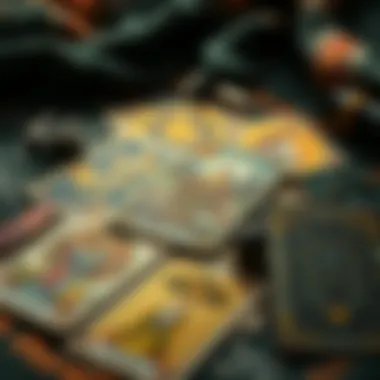
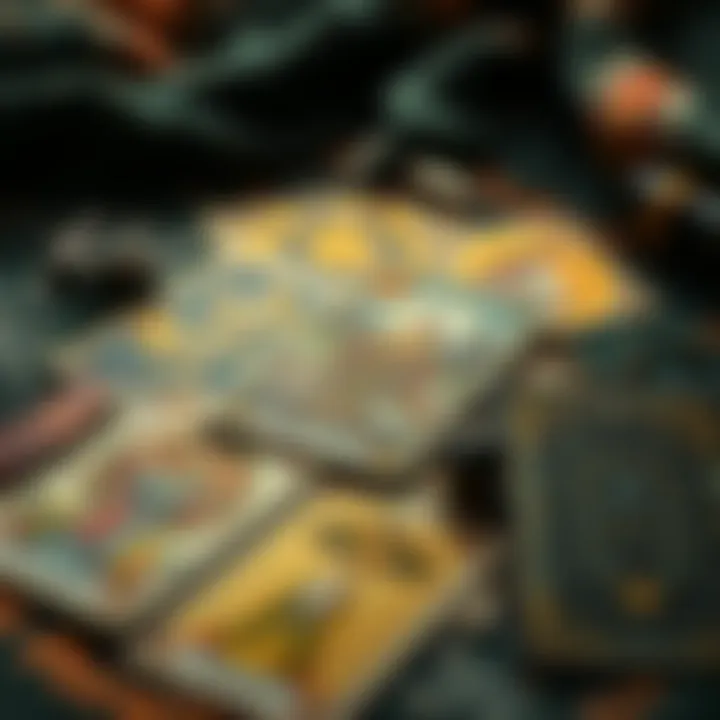
Single Card Spread
The single card spread stands out for its simplicity and direct approach. In this method, only one card is drawn from the deck, which can reflect a specific question or intention. Its key characteristic is its focus on clarity. This spread is beneficial for those looking for immediate insights, making it a popular choice among both beginners and seasoned readers.
One unique feature of the single card spread is how it can represent various aspects of life at any given moment. What distinguishes it further is its versatility; it can address relationship inquiries, professional queries, or personal guidance without needing elaborate interpretations. The advantage here lies in its straightforward nature, which encourages a reader’s intuition to shine. However, the disadvantage may be that it lacks depth in context; sometimes a single card cannot capture the complexities of a situation.
Celtic Cross
On the opposite end of the spectrum lies the Celtic Cross spread, a more intricate structure that offers in-depth analysis. Its key characteristic is its layered examination of a situation, showcasing ten positions that reveal various influences and directions. This method is widely recognized for its depth and comprehensive nature, making it a favorite among those seeking a thorough understanding of circumstances.
The unique feature of the Celtic Cross is its layout, which covers the past, present, future, and other critical factors affecting a situation. Readers can gather a broad spectrum of insights in one go, leading to a well-rounded reading. The advantages of this approach include the ability to delve into multiple dimensions of a question, while the disadvantages could be its complexity—for some, it might seem overwhelming and require more experience to interpret accurately.
Interpreting Card Combinations
Interpreting card combinations is where the magic truly happens. Just like a chef skillfully combines herbs and spices to create a dish, card readers weave meanings together for a holistic view. Individual cards possess meanings, but when placed side by side, their interpretations can shift dramatically. Contextual understanding is key here; a card representing conflict could take on a different shade of meaning depending on the other cards present.
This technique allows for a rich narrative to unfold, enabling readers to piece together diverse elements that speak to the complexities of life situations. Readers hone their skills by practicing combinations and refining their intuition through these interactions, ultimately leading to more profound insights.
"The workings of the deck are not fixed; they are a vibrant dance, reflecting the rhythm of life’s uncertainties."
As readers develop their comprehension of combinations over time, they cultivate flexibility in their interpretations, allowing for more nuanced readings that resonate with clients on a personal level.
Ethics and Responsibilities in Card Reading
The world of card reading is often steeped in mystery and allure, but with this power comes an undeniable weight of ethical responsibility. Understanding the implications of fortune telling is crucial, not just for practitioners but also for the individuals seeking insight through these arts. As we navigate through this intricate landscape, it is imperative to acknowledge that ethical practices provide a foundation of trust and respect between the reader and the client. In this section, three vital aspects will be discussed: maintaining client confidentiality, balancing guidance with free will, and addressing the needs of vulnerable clients.
Maintaining Client Confidentiality
Client confidentiality is the cornerstone of any disciplined card reading practice. When individuals open up about their innermost concerns, it is paramount that they trust their reader to keep those insights private. Just like a secret whispered between friends, no one wants their personal matters broadcasted to the world. Breaching this trust can not only damage the relationship between the reader and client, but it can also tarnish the reputation of the profession as a whole.
This requires practitioners to approach each reading with a strong ethical framework:
- Clear Boundaries: Establish what information is confidential from the start.
- Secure Handling of Information: Be diligent in how personal notes or records are stored.
- Anonymity in Discussions: When discussing cases with other professionals, ensure anonymity to protect the identities involved.
By fostering a sense of security around privacy, a reader cultivates a supportive environment, encouraging individuals to seek guidance without fear of exposure.
Balancing Guidance and Free Will
One of the most nuanced challenges in card reading is the delicate equilibrium between offering guidance and respecting a client's autonomy. After all, while the cards can highlight possible paths and outcomes, they should never dictate an individual's choices. Ensuring the client’s ability to exercise their free will is paramount in realizing ethical card reading.
A competent reader should:
- Present Options: Frame insights as different avenues rather than fixed destinies.
- Encourage Reflection: Invite clients to reflect on how the cards resonate with their situation and to contemplate various approaches to their challenges.
- Steer Clear of Absolutes: Phrases like “You must do this…” can be harmful. Instead, opt for language that empowers clients to choose their path.
This approach honors the client’s inherent ability to shape their lives while also offering gentle direction when needed.
Addressing Vulnerable Clients
In a world where individuals often seek card readings during times of crisis, a reader may frequently encounter clients who are particularly vulnerable. It might be a person grappling with grief, anxiety, or significant life changes. This demographic requires an elevated level of empathy and care in the reading process.
Practitioners should consider the following:
- Assess Emotional State: Before diving into a reading, take a moment to gauge the client's emotional state. This can help tailor the session to their current mindset.
- Provide Supportive Space: Make it clear that your role is to provide insight, not to replace professional mental health support. If a client is in distress, they may need guidance that goes beyond cards.
- Follow-Up Care: A simple follow-up message after a reading can go a long way to show that you care about their wellbeing.
"A reading is not merely about the cards drawn, but it’s about the connection and respect cultivated in that moment."
Skepticism and Belief in Card Reading
Skepticism and belief are two sides of the same coin when it comes to the art of card reading. On one hand, skeptics question the validity of the practice, often attributing successes to coincidence or psychological manipulation. Conversely, believers see the practice as a genuine connection to the unseen forces of the universe. It's crucial to address this duality, as the impact on both practitioners and clients is profound.
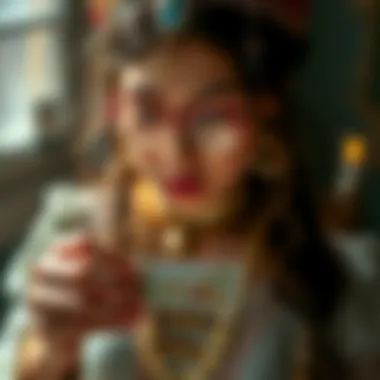
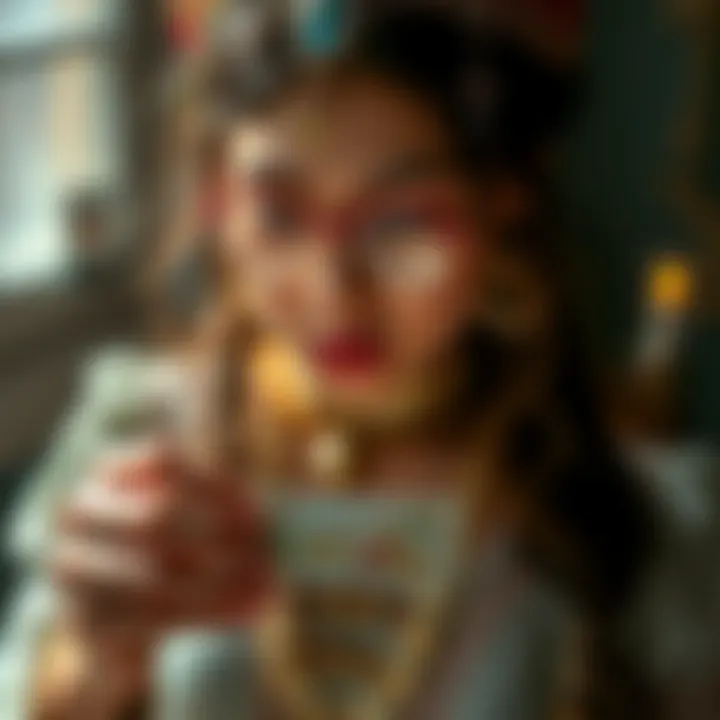
Many individuals come to card reading hoping for guidance, clarity, or reassurance. However, the skepticism that surrounds this field can create a barrier. Acknowledging the doubts helps to make the readings more meaningful. When readers understand skepticism, they can offer rationale, easing fears and allowing for open dialogue about the insights provided during a session. This creates a more authentic experience.
Addressing Common Misconceptions
A large part of skepticism arises from misconceptions about card reading. Below are some prevalent misunderstandings:
- Card Readers Predict the Future: It's often believed that card readers offer literal predictions. In reality, card reading leans towards interpretation, suggesting possibilities rather than certainties.
- Cards Have Magical Powers: Many think that the cards themselves hold magical properties. Instead, it’s the reader’s intuition and skill that makes a reading impactful.
- Only Certain People Can Read Cards: There’s a notion that card reading is a gift possessed by a select few. Actually, anyone can learn the techniques and insights necessary for effective readings with practice and dedication.
Addressing these misconceptions not only demystifies the practice but can also build trust with clients. Educating both skeptics and believers can pave the way for a more nuanced understanding of card reading.
The Scientific Perspective
A scientific examination of card reading reveals compelling insights about human psychology. Researchers have found that belief in the power of card readings often aligns with cognitive phenomena such as confirmation bias. This means people are likely to remember the accurate predictions while dismissing the inaccurate ones.
Furthermore, psychological studies highlight how the uncertainty of life causes many individuals to seek out meaning through various channels, card reading included. The phenomenon of the placebo effect plays a role here, as belief in the efficacy of a reading can lead to positive outcomes simply because of the individual's conviction.
In this light, it’s essential for card readers to recognize that their role can act as facilitators of psychological healing. Treatments and readings should be framed in a way that maximizes their benefit while minimizing potential harm, especially when dealing with vulnerable clients.
Embracing Personal Insights
Embracing personal insights from card readings is where the true magic lies. For believers, the cards often serve as mirrors, reflecting inner truths and external situations. Here are a few ways individuals can extract personal insights:
- Journaling After a Reading: Writing down feelings and thoughts post-reading can deepen understanding. It allows for reflection on the insights gained and how they might apply to one's life.
- Meditation on Card Imagery: Focusing on the imagery of the cards can unlock subconscious thoughts and feelings. This reflective practice strengthens personal interpretation.
- Engaging with the Community: Sharing experiences with fellow card enthusiasts can provide diverse perspectives, enhancing one's own understanding.
In the end, whether one leans towards skepticism or belief, card reading can serve as a tool for personal development. By weaving together insight from both perspective, readers and clients can navigate life’s uncertainties more skillfully, leading to increased self-awareness and growth.
"It’s our perceptions that shape our realities; understanding both sides fosters a richer experience of card reading."
For further exploration into the subject, visit Wikipedia on Tarot or engage with communities on Reddit. The deeper one delves into the mechanics of card reading, the more profound the insights become.
Future Trends in Card Reading
As the world shifts and changes, so does the practice of card reading. The future of this ancient art is not just about preserving tradition but also about embracing new technologies and evolving practices. Emphasizing the significance of Future Trends in Card Reading, we see a unique blend of history and modernity, where innovation paves the way for deeper insights and broader reach. Exploring these trends is essential, as they present opportunities for fortune tellers to expand their craft, diversify their offerings, and connect with a larger audience.
Digital Platforms and Readings
The digital age has transformed many aspects of life, and fortune telling is no exception. Online platforms have emerged, making it easier for practitioners to reach clients far beyond their geographical boundaries. Services like Keen and Kasamba allow readers to conduct sessions via video calls, chats, or even email exchanges.
This shift to digital spaces has multiple advantages:
- Accessibility: Anyone with an internet connection can seek guidance, regardless of location.
- Diverse Offerings: Online platforms enable card readers to showcase their specialties, from tarot readings to oracle interpretations, making it easier for clients to find a match.
- Client Anonymity: Some individuals prefer the anonymity that online platforms provide, which can lead to more open discussions during readings.
However, this trend is not without its challenges. The personal touch found in face-to-face meetings can sometimes feel lost in virtual consultations. It's crucial for readers to develop strong communication skills to make clients feel at ease through a screen.
Emerging Decks and Innovations
The continuous evolution of card reading is mirrored in the development of innovative decks. While traditional tarot and oracle cards have their steadfast followers, newer decks are being crafted with unique themes and artistry. For instance, decks inspired by contemporary storytelling or even pop culture are gaining traction.
These emerging decks serve several purposes:
- Inspiring Creativity: New designs breathe fresh life into readings, allowing for unique interpretations based on the creator's intent.
- Cultural Representation: Many new decks reflect diverse backgrounds, promoting inclusivity within the card reading community.
- Nuanced Readings: Having varied decks means a wider array of symbols and meanings to work with, which can enhance personal or collective insights.
Readers who stay abreast of these advancements can offer clients up-to-date experiences that resonate with current societal themes. This adaptability will keep practitioners relevant in a dynamically changing landscape.
The Role of Community
In a world characterized by individualism, the sense of community within the card reading world remains crucial. Social media platforms like Facebook and Reddit have become hubs for aspiring and seasoned readers to share insights, exchange techniques, and support one another.
Some key aspects of community involvement include:
- Networking: Building connections with peers can foster professional growth and lead to collaborations.
- Mentorship: Experienced readers often find fulfillment in guiding newcomers, creating a positive cycle of learning.
- Resource Sharing: Communities frequently share materials— from deck recommendations to study guides, providing valuable support.
Establishing a sense of belonging can also enhance the self-esteem and confidence of card readers, empowering them to explore and expand their unique styles of reading. The future, therefore, lies not just in individual exploration but in the strength of community connections.
"Together we rise, by lifting each other up in our journeys—this is the crux of our community in card reading."
Exploring these modern trends in card reading opens doors to enriched experiences, fosters deeper understanding, and encourages growth among practitioners. As we embrace innovation while honoring the past, the future of card reading appears vibrant and promising.



